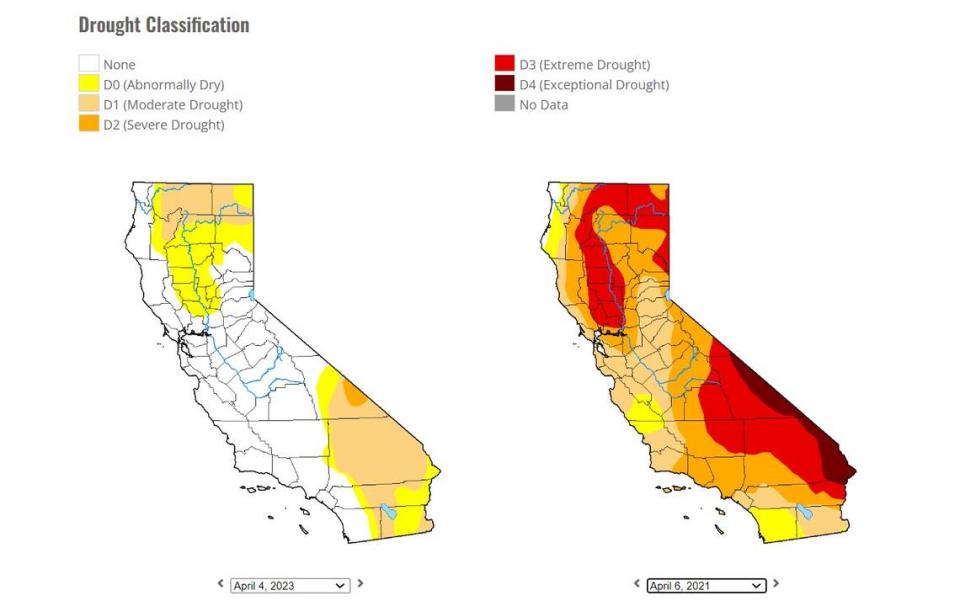How does California define drought? April update shows 75% of state recovered
After months of continuous wet weather, California’s drought is leaps and bounds from where it was this time two years ago — a reflection of both extreme rain and one of the state’s largest snowpacks on record.
California entered what would be its driest three-year-stretch in 2020 and Gov. Gavin Newsom’s decision in March to lift drought measures signaled a near end to the three-year plight. The state continues to reap the benefits of a wet water year as moderate and severe drought conditions slowly diminish in both the northern and southern areas, according to the U.S. Drought Monitor.

In April 2021, more than 99% of the state was at least abnormally dry. Now, it’s at 43.8%. Roughly 25% of the state has at least moderate drought — an improvement from 92.7% nearly two years ago — and less than 1% remains in severe drought compared to 69.7%
Since January, the state has been free of “extreme” or “exceptional” drought. In April 2021, more than 35% of the state was battling “extreme” conditions and more than 5% of the state was in “exceptional” drought status.
The state is now more than 75% drought-free.
As the state inches closer to completely drought-free conditions, Bee reader Ray Riehle reached out to our service team curious how drought is defined as well as the metrics used to determine the level of each drought condition: “What does it mean to be D0 (Abnormally Dry), D1 (Moderate Drought), D2 (Severe Drought), D3 (Extreme Drought), D4 (Exceptional Drought).”
How drought is defined in California?
Drought is a moisture deficit — the amount of water the state has compared to the amount of water it can hold — causing social, environmental or economical effects, according to the U.S. Drought Monitor.
The U.S. Drought Monitor provides a “big picture” of drought statutes across the U.S., from least intense (D1) to the most intense (D4):
Abnormally dry (D0)
Short-term dryness that slows planting and the growth of crops and grasslands
Crops and grasslands are not fully recovered
Lingering water deficits
Moderate drought (D1)
Some damage to crops and grasslands
Streams and reservoirs are low
Water shortages are developing
Voluntary water restrictions are requested
Severe drought (D2)
Loss of crops and grasslands is likely
Water shortages are common
Water restrictions are enforced
Extreme drought (D3)
Major losses to crops and grasslands
Widespread water shortages or restrictions
Exceptional drought (D4)
Exceptional and widespread loss to crops and grasslands
Water shortages in streams and reservoirs create water emergencies
Northern California farmers saw crops drown in rain. Will it hurt local market prices?
Is California still in a drought?
Every week, California moves further away from its drought-stricken conditions.
But there is still work to do.
Roughly 3.2 million people remain in drought areas, according to a March 30 update from the U.S. Drought Monitor. Meaning, whether or not the drought is over is dependent on where you are and the status of your agency’s supply.
The information used in this interactive map, collected from the U.S. Drought Monitor, was updated Thursday with data through April 4. Here are the drought conditions in California. See where your area lands:
When will it rain and snow again in California?
There’s a light at the end of the tunnel as California slowly warms up, but not before the typical spring showers.
In Northern California, wind gusts between 30 mph and 35 mph coupled with light rain is forecast from Thursday to Saturday. Then warm temperatures will follow, according to the National Weather Service.
Temperatures in Sacramento could reach 76 degrees on Sunday.
We're almost there.
Your patience will pay off.
After some light precipitation later today & early tomorrow, warmer temperatures are riiiiiiiight around the corner with above normal highs forecast by Sunday. ️ #CAwx pic.twitter.com/lK8R0nlxVy— NWS Sacramento (@NWSSacramento) April 6, 2023
Light to moderate mountain snow will fall Thursday night into Friday afternoon in the Sierra Nevada and southern Cascades with amounts between 2 to 8 inches above 5,500 feet.
What do you want to know about life in Sacramento? Ask our service journalism team your top-of-mind questions in the module below or email servicejournalists@sacbee.com.

